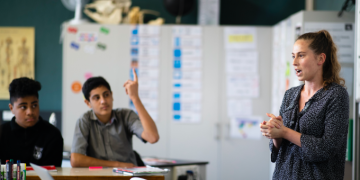Pedagogical design
SOLO Taxonomy, Universal Design for Learning and Digital Technologies underpin our learning resources.







Multiple approaches
The resources for year 9-10 are designed to have several points of entry for both teachers and students:
- They can be used for whole class instruction and directed teaching for schools that integrate learning areas.
- Students can also work independently or in groups to select their own learning experiences. This allows them to build knowledge and practice skills at the time they need them, and gives students the ability to work at their own pace
- The resources allow further differentiation by allowing additional choices for students to select their own content and product outcomes.
For schools that don’t have a thematic approach, teachers and students can enter through the different learning areas.
The resource design allows for student agency and builds the skills in info-literacy and info-numeracy, which enable students to become independent inquirers and learners. Student agency is also advocated through the design.
These resources are suitable for different school structures and learning environments.
- If teaching in a modern learning environment, they can be used as either teacher led lessons or for students to work individually at their own pace. Students can select learning areas that they want to work in, as negotiated with teachers, to personalise and pace their own learning
- If teaching in a more conventional classroom setting, teachers can group with other learning area specialists and use the resources across each learning area
- These resources could be taught in separate learning areas by one teacher.
SOLO Taxonomy
Learning experiences and formative assessment tasks have been aligned to SOLO Taxonomy to ensure cohesiveness, constructive alignment, and cognitive stretch for all students. This gives teachers and students choice throughout the learning and teaching process.
In these resources SOLO Taxonomy has been aligned to the following headings:
| Need It / Know It | Think It / Link It | Extend It / Defend It |
|---|---|---|
Prestructural
Student outcomes are not relevant to context.
Unistructural
Student outcomes are limited to single relevant responses. They can list, describe, or define one idea about the context.
Multistructural (Need it/Know it)
Students bring in relevant pieces of information and prior knowledge by listing, describing, or defining. The information gathered in this phase is the content knowledge that is required as the starting point for new learning about financial capability.
Relational (Link it/Think it)
Students make connections with the information they have to make new learning by comparing, analysing, sequencing, explaining, classifying, relevant questioning, and analogising. These connections enable students to build new knowledge and understandings around their financial capability by learning about the perspectives and insights of others.
Extended Abstract (Extend it/Defend it)
Students extend their new learning by applying it in a new context – the “so what” of learning. They defend their thinking by evaluating, generalising, predicting, finding evidence, validating sources, and presenting their findings in an authentic way to create meaning around their financial capability.
Universal design for learning
Universal design for learning is a research-based framework that helps teachers plan learning to meet the diverse and variable needs of all students. This approach supports schools to realise the vision of The New Zealand Curriculum.
Universal design for learning is incorporated into these resources through nine strategies:
|
PROVIDE MULTIPLE MEANS OF REPRESENTATION |
PROVIDE MULTIPLE MEANS OF ACTION AND EXPRESSION |
PROVIDE MULTIPLE MEANS OF ENGAGEMENT
|
|---|---|---|
|
Provide options for perception
Research material is collated and easily accessible.
A range of sources allows for choice of delivery options.
Choice of how students would like to share information supports differentiated learning. |
Provide options for physical action
Multiple opportunities to access digital technologies.
Multiple opportunities to access tools to support learning.
|
Provide options for recruiting interest
Linking the what, why, and how of the learning process.
Collaborative opportunities available for group work.
Problem solving approaches built into tasks with a fun factor element.
Future thinking brings a new perspective, and some quirkiness in thinking activities allow for creative outputs.
Links to prior knowledge and personal experience to make learning authentic.
New perspectives and insights available through question prompts.
Competitive elements available in the problem solving resources.
Learning is differentiated and provided through a variety of media.
|
|
Provide options for using language and symbols
Definition prompts available in design of student learning experiences.
Use of different tools to help with decoding of mathematical notation.
Key concepts are identified throughout process.
|
Provide options for expressive skills and fluency
Students have a range of tasks to choose from, and can work individually or collaboratively.
Variety of tools and strategies to support diversity in learning. Not a one fit for all approach.
Learning is scaffolded with appropriate processes.
Content guided but choice within how students communicate new learning.
|
Provide options for sustaining effort and persistence
Overview supporting the resource is apparent to students.
Clear links with learning and expected outcomes.
Learning is guided and proximal allowing for challenge to be achievable. Success and a fun element built into teaching resources.
Choice is supported and encouraged.
Collaboration and collective thinking is encouraged with problem solving learning experiences included.
|
|
Provide options for comprehension
Questions and learning experiences promote sharing of prior knowledge.
Prior knowledge is valued and shared so learning can be connected to student.
Opportunities to involve family and whānau in learning available.
Identification of main ideas and definition can be readily accessed and are replicated in all resources. |
Provide options for executive functions
Links between learning and expected outcomes are purposeful.
Tasks that support individual goal setting.
Options available to support learners plan, monitor, and assess their progress through formative assessment.
Research and support material is relevant and accessible to complete outcomes.
|
Provide options for self-regulation
Self-management tools to plan, monitor, and evaluate progress in the form of formative assessments that align to each learning area.
|
Digital Technologies
Sorted in Schools supports teachers to strengthen digital technology learning in New Zealand classrooms, especially in a financial capability context.
The New Zealand Digital Technologies Curriculum directs schools to ensure students are: ‘learning about digital technologies, becoming creators of digital technologies and using that knowledge to solve real world problems.’ The learning experiences included within our resources are created to meet those aims and help students become digitally capable.
Our resources also support the Learning and Teaching dimension within the eLearning Planning Framework. This enables learning and teaching to transition from engaging to extending, to empowering students and teachers.
The Digital Technologies resources currently available on our website are:
Teaching Resources
Exploring Financial Identity
through Digital Technologies Learning Plan and Assessment Guide
Learning Resources
These can be found under the Resource area - apply the ‘Digital Technologies’ filter.
Scratch (create stories, games and animations) coding programme.
Digital Media Production
Online interactive activities: Supermarket Shopper
Online surveys: Survey Monkey.



Download PDF
Māori Medium Education
Written in te reo Māori with resources aligned to Te Marautanga o Te Aho Matua and Te Marautanga o Aotearoa.

















